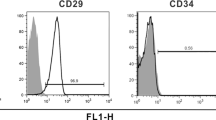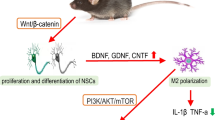Abstract
This study determined the effects of pcDNA3-β-nerve growth factor (NGF) gene-modified bone marrow stromal cells (BMSC) on the rat model of Parkinson’s disease (PD). The recombinant plasmid pcDNA3-β-NGF was transfected into BMSC, and NGF expression and its biological activity in vitro were detected. BMSC modified by the NGF gene were then grafted into the corpus striatum of PD rats, and the rotation behavior was evaluated at 1, 2, 4, and 6 weeks post-transplantation. A significant improvement in rotation behavior was observed in PD rats subjected to cell transplantation, especially in PD rats receiving NGF-modified BMSC. The genetically modified BMSC survived and expressed β-NGF but did not differentiate into tyrosine hydroxylase-positive cells in vivo. The present findings suggested that genetically modified BMSC could be effective for PD treatment, and the mechanisms might involve the neuroprotective effects of β-NGF.







Similar content being viewed by others
References
Arimatsu, Y., & Miyamoto, M. (1991). Survival-promoting effect of NGF on in vitro septohippocampal neurons with cholinergic and GABAergic phenotypes. Brain Research: Developmental Brain Research, 58, 189–201.
Bao, X. M., & Shu, S. Y. (1991). The stereotaxic atlas of the rat brain. Peking: The People’s Medical.
Barone, P., Bravi, D., Bermejo-Pareja, F., et al. (1999). Pergolide monotherapy in the treatment of early PD: A randomized, controlled study. Pergolide Monotherapy Study Group. Neurology, 53, 573–579.
Chaturvedi, R. K., Shukla, S., Seth, K., & Agrawal, A. K. (2006). Nerve growth factor increases survival of dopaminergic graft, rescue nigral dopaminergic neurons and restores functional deficits in rat model of Parkinson’s disease. Neuroscience Letters, 398, 44–49.
Chen, C. J., Ou, Y. C., Liao, S. L., et al. (2007). Transplantation of bone marrow stromal cells for peripheral nerve repair. Experimental Neurology, 204, 443–453.
Clarke, C. E., & Deane, K. H. (2001). Ropinirole for levodopa-induced complications in Parkinson’s disease. Cochrane Database of Systematic Reviews, 1, CD001516.
Deng, W., Obrocka, M., Fischer, I., & Prockop, D. J. (2001). In vitro differentiation of human marrow stromal cells into early progenitors of neural cells by conditions that increase intracellular cyclic AMP. Biochemical and Biophysical Research Communications, 282, 148–152.
Fernandez-Espejo, E., Armengol, J. A., Flores, J. A., Galan-Rodriguez, B., & Ramiro, S. (2005). Cells of the sympathoadrenal lineage: Biological properties as donor tissue for cell-replacement therapies for Parkinson’s disease. Brain Research: Brain Research Reviews, 49, 343–354.
Freed, C. R., Greene, P. E., Breeze, R. E., et al. (2001). Transplantation of embryonic dopamine neurons for severe Parkinson’s disease. New England Journal of Medicine, 344, 710–719.
Hefti, F., Melamed, E., Sahakian, B. J., & Wurtman, R. J. (1980). Circling behavior in rats with partial, unilateral nigro-striatal lesions: Effect of amphetamine, apomorphine, and DOPA. Pharmacology, Biochemistry and Behavior, 12, 185–188.
Hirata, Y., Meguro, T., & Kiuchi, K. (2006). Differential effect of nerve growth factor on dopaminergic neurotoxin-induced apoptosis. Journal of Neurochemistry, 99, 416–425.
Hofstetter, C. P., Schwarz, E. J., Hess, D., et al. (2002). Marrow stromal cells form guiding strands in the injured spinal cord and promote recovery. Proceedings of the National Academy of Sciences of the United States of America, 99, 2199–2204.
Kavanagh, E. T., Loughlin, J., PHerbert, K. R., et al. (2006). Functionality of NGF-protected PC12 cells following exposure to 6-hydroxydopamine. Biochemical and Biophysical Research Communications, 351, 890–895.
Kim, B. J., Seo, J. H., Bubien, J. K., & Oh, Y. S. (2002). Differentiation of adult bone marrow stem cells into neuroprogenitor cells in vitro. Neuroreport, 13, 1185–1188.
Kohyama, J., Abe, H., Shimazaki, T., et al. (2001). Brain from bone: Efficient “meta-differentiation” of marrow stroma-derived mature osteoblasts to neurons with Noggin or a demethylating agent. Differentiation, 68, 235–244.
Kopen, G. C., Prockop, D. J., & Phinney, D. G. (1999). Marrow stromal cells migrate throughout forebrain and cerebellum, and they differentiate into astrocytes after injection into neonatal mouse brains. Proceedings of the National Academy of Sciences of the United States of America, 96, 10711–10716.
Li, Y., Chen, J., Wang, L., Lu, M., & Chopp, M. (2001). Treatment of stroke in rat with intracarotid administration of marrow stromal cells. Neurology, 56, 1666–1672.
Li, F. Q., Wang, T. H., Dong, J., et al. (2005). Construction and identification of eukaryotic cell expression vector of human nerve growth factor beta gene. Sichuan Journal of Anatomy, 12, 2–5.
Lu, D., Li, Y., Wang, L., Chen, J., Mahmood, A., & Chopp, M. (2001). Intraarterial administration of a marrow stromal cells in a rat model of traumatic brain injury. Journal of Neurotrauma, 18, 813–819.
Mareddy, S., Crawford, R., Brooke, G., & Xiao, Y. (2007). Clonal isolation and characterization of bone marrow stromal cells from patients with osteoarthritis. Tissue Engineering, 13, 819–829.
Minguell, J. J., Erices, A., & Conget, P. (2001). Mesenchymal stem cells. Experimental Biology and Medicine (Maywood), 226, 507–520.
Miyasaki, J. M., Martin, W., Suchowersky, O., Weiner, W. J., & Lang, A. E. (2002). Practice parameter: Initiation of treatment for Parkinson’s disease: An evidence-based review: Report of the Quality Standards Subcommittee of the American Academy of Neurology. Neurology, 58, 11–17.
Nutt, J. G., & Wooten, G. F. (2005). Clinical practice. Diagnosis and initial management of Parkinson’s disease. New England Journal of Medicine, 353, 1021–1027.
Offen, D., Barhum, Y., Levy, Y. S., et al. (2007). Intrastriatal transplantation of mouse bone marrow-derived stem cells improves motor behavior in a mouse model of Parkinson’s disease. Journal of Neural Transmission, Supplementum, 72, 133–143.
Pittenger, M. F., Mackay, A. M., Beck, S. C., et al. (1999). Multilineage potential of adult human mesenchymal stem cells. Science, 284, 143–147.
Pradier, P., Jalenques, I., Dalle, M., Reuling, R., Despres, G., & Romand, R. (1994). Distribution and metabolism patterns of plasma 7S- and beta-NGF in the adult male rat. Journal of Physiology Paris, 88, 273–277.
Prockop, D. J. (1997). Marrow stromal cells as stem cells for nonhematopoietic tissues. Science, 276, 71–74.
Sanchez-Ramos, J., Song, S., Cardozo-Pelaez, F., et al. (2000). Adult bone marrow stromal cells differentiate into neural cells in vitro. Experimental Neurology, 164, 247–256.
Schwarting, R. K., & Huston, J. P. (1996). Unilateral 6-hydroxydopamine lesions of meso-striatal dopamine neurons and their physiological sequelae. Progress in Neurobiology, 49, 215–266.
Schwarting, R. K., Huston, J. P., et al. (1996). The unilateral 6-hydroxydopamine lesion model in behavioral brain research: Analysis of functional deficits, recovery and treatments. Progress in Neurobiology, 50, 275–331.
Tseng, P. Y., Chen, C. J., Sheu, C. C., Yu, C. W., & Huang, Y. S. (2007). Spontaneous differentiation of adult rat marrow stromal cells in a long-term culture. Journal of Veterinary Medical Science, 69, 95–102.
Ungerstedt, U., & Arbuthnott, G. W. (1970). Quantitative recording of rotational behavior in rats after 6-hydroxy-dopamine lesions of the nigrostriatal dopamine system. Brain Research, 24, 485–493.
Wei, P., Liu, J., Zhou, H. L., et al. (2007). Effects of engrafted neural stem cells derived from GFP transgenic mice in Parkinson’s disease rats. Neuroscience Letters, 419, 49–54.
Wu, Q. Y., Li, J., Feng, Z. T., & Wang, T. H. (2007). Bone marrow stromal cells of transgenic mice can improve the cognitive ability of an Alzheimer’s disease rat model. Neuroscience Letters, 417, 281–285.
Ye, M., Wang, X. J., Zhang, Y. H., et al. (2007a). Therapeutic effects of differentiated bone marrow stromal cell transplantation on rat models of Parkinson’s disease. Parkinsonism & Related Disorders, 13, 44–49.
Ye, M., Wang, X. J., Zhang, Y. H., et al. (2007b). Transplantation of bone marrow stromal cells containing the neurturin gene in rat model of Parkinson’s disease. Brain Research, 1142, 206–216.
Acknowledgments
We thank Dr. S. K. Leong for his invaluable comments in the writing of this manuscript. This work was supported by the international collaboration grant of China Chunhui plan (Z2003-1-53013 and Z2005-1-53002), National Natural Science Foundation (no. 30660050) and the Chinese Medical Board of New York (CMB-00-72).
Author information
Authors and Affiliations
Corresponding author
Additional information
The contribution of Zhong-Tang Feng is equal to the first author.
Rights and permissions
About this article
Cite this article
Wang, TH., Feng, ZT., Wei, P. et al. Effects of pcDNA3-β-NGF Gene-modified BMSC on the Rat Model of Parkinson’s Disease. J Mol Neurosci 35, 161–169 (2008). https://doi.org/10.1007/s12031-007-9032-8
Received:
Accepted:
Published:
Issue Date:
DOI: https://doi.org/10.1007/s12031-007-9032-8




